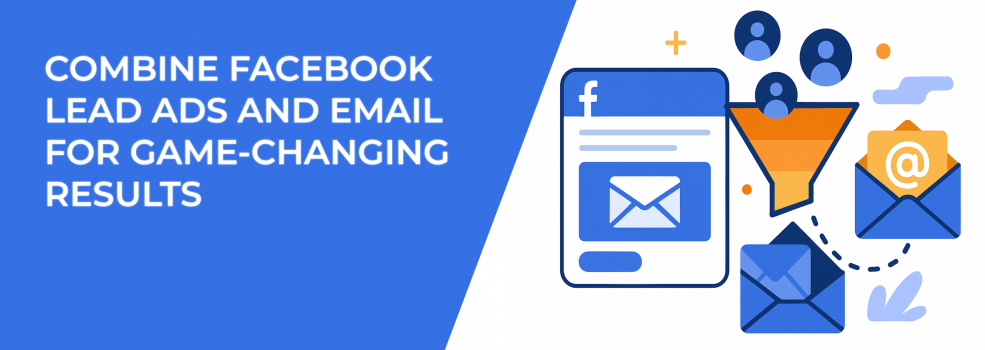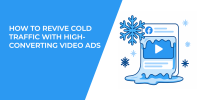Capturing interest through Facebook Lead Ads is a smart first step. The format is designed for convenience — fast, native to mobile, and user-friendly. But generating leads is only part of the equation.
The real challenge is turning that interest into meaningful action.
Many advertisers focus on getting the form filled but overlook what happens next. Without a clear, timely follow-up strategy, most leads lose relevance quickly. People move on. They forget why they clicked. Or they find alternatives that respond more quickly and more directly.
The most effective approach combines the ease of Facebook Lead Ads with a structured, personalized email strategy. That’s how you create a real path from inquiry to conversion.
Let's see how to build that system.
Why Facebook Lead Ads aren’t enough for lead generation
Facebook Lead Ads work well for capturing user information with minimal friction. They pre-fill details like name and email, keeping users inside the platform and reducing drop-off. But interest at the point of submission is typically low-commitment — more exploratory than decisive.
This is where advertisers often miscalculate. A new lead isn’t a customer; it’s an opportunity to start a relevant conversation.
Delaying contact or sending a generic message creates unnecessary distance. Users expect clear communication and fast follow-up. The longer you wait, the harder it becomes to re-engage them meaningfully.
That’s why a well-timed email strategy isn’t a bonus — it’s essential.
But first, you need to understand how Facebook Lead Ads format and features actually work. Start there, and then get to the next step.
Set up your CRM or email platform to work with Lead Ads
The first practical step is integrating your Facebook Lead Ads with your CRM or email automation tool. Whether you’re using HubSpot, Salesforce, Mailchimp, ActiveCampaign, or another platform, most tools now support direct connections through Meta Business Suite.
If your system isn’t on the official integration list, third-party connectors like Zapier allow you to automate lead capture and response efficiently.
This setup ensures that as soon as a user submits their details, your system can respond without delay.
Implementation tip: use lead form labels or campaign identifiers in your integration setup. This allows your system to send messages that reflect the specific ad the user responded to — making your communication more relevant and consistent.
Additionally, make sure your privacy disclosures are visible and your opt-in process aligns with data protection regulations like GDPR or CAN-SPAM.Create emails that feel personal and provide value
Once a lead is captured, your first email becomes your brand’s introduction. It needs to do more than confirm receipt — it should offer context, clarity, and an actionable next step.
Avoid generic messages. A simple “Thanks” with no direction or detail often feels automated and impersonal.
Your first message should deliver the promised content — whether it’s a downloadable asset, booking link, or promo code — and provide a reason to stay engaged.
Here are the key elements of an effective first email:
A subject line that matches the user’s expectations.
A short, friendly introduction that reflects your brand voice.
One clear next step — like booking a time, accessing a product, or learning more.
A reason to anticipate future messages — useful insights, exclusive access, or helpful content.
Think beyond single emails and design a short sequence that continues the conversation. For example, if you’re offering a free consultation for a home service:
Email 1 (Immediate): Confirm the request and provide appointment details.
Email 2 (Day 1): Share a customer story relevant to the user’s service type or location.
Email 3 (Day 3): Address common questions or hesitations about the service.
Email 4 (Day 5): Introduce a limited-time offer or added benefit.
Email 5 (Week 2): Encourage ongoing engagement or referrals.
Each message builds on the last, moving the lead toward action without pressure.
Check timing and frequency
Responding quickly after a lead submits their information is one of the most important factors in engagement. Research shows that the first five minutes after submission are critical — not just for open rates but for conversion potential.
But it’s not only about speed. The cadence and content of your follow-up sequence also matter.
Here’s a typical timing model that works well across industries:
First 5 minutes: deliver the promised asset or confirmation.
Next 6–12 hours: share related information that adds value or clarifies next steps.
Within 72 hours: present your offer, booking link, or product introduction.
After one week: transition to a longer-term nurture campaign with educational or supportive content.
As for frequency, early touchpoints are important, but you should avoid overwhelming your leads. Two to three emails in the first few days is usually a good starting point, followed by weekly or biweekly check-ins that maintain relevance.
Optimization tip: use behavioral triggers to shape your sequence. If someone clicks a product link or views a pricing page, tailor the next email to reflect that interest. Most CRM tools support tagging and conditional logic that make this easier to manage.Example of turning interest into engagement
Imagine you run an independent skincare brand that promotes free virtual consultations via Facebook Lead Ads.
Here’s how your email sequence might look:
Email 1 (Immediately): confirmation with a consultation booking link and a short message from the founder.
Email 2 (Next Day): a skincare tip that connects with the type of consultation selected — acne, dryness, or anti-aging.
Email 3 (Day 3): a curated product recommendation and a discount for first-time buyers.
Email 4 (Day 6): a case study or customer spotlight highlighting results from similar users.
Email 5 (Day 10): a final reminder to book, along with an optional link to reply with questions.
This kind of sequence reinforces trust, builds interest, and encourages action without overwhelming the user.
Treat the follow-up as the core of your strategy
Capturing a lead is only the beginning: the outcome depends entirely on what you do afterward.
Focusing only on metrics like cost-per-lead can be misleading. What matters more is the quality of your follow-up — how quickly and thoughtfully you engage, and whether you provide something useful or relevant.
By combining the reach of Facebook Lead Ads with structured, timely email automation, you can turn passive leads into engaged prospects and ultimately into paying customers. For a broader look at how lead generation is evolving this year, explore the top-performing lead generation tactics.

